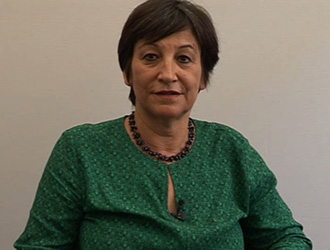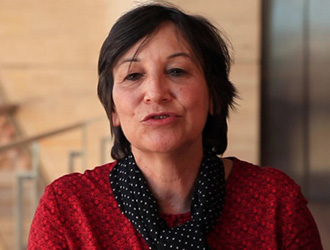The dense cities are in the spotlight due to the impact of the pandemics COVID-19. In this interview, Carme Ribas, a Barcelona architect and president of the 2014 award of the European Prize for Urban Public Space discusses the future prospects of cities.
A great defender of public space, Ribas analyses, in the conversation with Manuel Lillo, director of the weekly newspaper El Temps, key issues like urban density, mobility, the renaturalisation of cities, and the relationship between public space and private space. Will the coronavirus reinforce the value of public space? Will our neighbourhoods change?
- In your biographical profile published by the CCCB, it says that you took part in the “democratisation of public spaces” in the early 1980s. What does “democratisation of public spaces” mean?
- We’re talking about many years ago, in the early days of the democratic City Council, when everything had to be done and everything had to be democratised. A lot of work was done, especially in reconstructing public space as a support for collective life. And, specifically, in Barcelona, good part of the public spaces were developed in the central zones but also in the peripheral neighbourhoods, with new parks and new squares being opened, historical fractures being mended, and new infrastructure introduced… This was the time when Oriol Bohigas was in the City Council, and he proposed “monumentalising the periphery”, which meant creating new centralities, with new public spaces that would give identity to each of the neighbourhoods that made up the city. A group of newly graduated young people, myself among them, worked to make this vision possible in the City Council.
- You’re speaking, though, of many years ago. Is it necessary now to “democratise” public space still more?
- It’s evident that this matter shouldn’t be abandoned. We can’t speak of public space without relating it to private space. We’re understanding more and more that these two spaces can’t be dissociated from one another. You can see this quite a lot in these days of COVID-19. Those who are suffering the worst effects of the virus are in neighbourhoods where the quality of private space is more deficient, and they need more than good public space. Now, as confinement is coming to an end, there’s more pressure on public space in neighbourhoods where private space is most substandard. We need to understand that working with public or collective space also means conceiving of private space in a different way. Private space must also have places for coexistence, community spaces which are very scarce in neighbourhoods where there is greater vulnerability because the homes are smaller. We’ve seen a lot of this from the standpoint of our profession: all social or protected housing has downsized collective spaces a lot. Now we’re realising that it’s very important to create units of coexistence that share certain common, community, “public” spaces. And, in future, this matter should be given very serious consideration.
- Do you think that the new reality that will be imposed in the period following the pandemic will boost awareness of needing to have these spaces?
- That’s how it should be. We should move towards a conception of housing as units of coexistence in which several more flexible spaces are shared, and that even give more importance to exteriors. For example, there are many homes and social housing programmes without access to roofs, where roofs aren’t understood as a shared space because this would complicate maintenance. I think that all this should be reconsidered and that, in dense cities like Barcelona, these spaces should be properly appreciated. -
- But could these spaces end up substituting for the role the street has played in public life so far?
- No. I think one thing is complemented by the other. The street will continue to be important because the street is democratic space par excellence. Or it should be. Now, with COVID-19, we’ll have problems with organising its uses. This problem already existed. But, at bottom, COVID-19 has magnified pending issues that we were already faced with, for example how to make harmonious coexistence democratically possible in the uses of public space but without negative competition.
- How is this done?
- For example, with changes in the model of mobility. It’s essential to reduce the percentage of public space occupied by the private vehicle, which is well above the proportion used by people who are moving around. One of the few positive results of the pandemic is that this is now on everyone’s agenda. In a shared space you have to choose what you prioritise. And it’s clear that private transport must be the big loser here and that, at last, we should be able to gain public space in a calmer way, let’s say, without vehement opposition and from so many actors, as has been the case so far over this issue. All of this is also important in relation with climate change. It’s important to see how quickly we’ve gone back to such low levels of contamination in the city … I didn’t expect this and, in particular, that it would happen so fast. It’s marvellous.
- Will the pandemic be of any use in making people aware of the need to limit the use of private transport? Will one thing lead to another? Will it influence those who have to make this decision at the institutional level?
- The recovery of environmental quality these days with the absence of contamination caused by cars has been such compelling evidence, I believe, that it would work in favour of many more people being willing to endeavour to keep things that way, and to sacrifice this part of the mobility system. I don’t have public opinion surveys, but I’d say that all this would help to take a step that has so far been very difficult to take.
- Do you think that the pandemic has changed people’s general perception of the street, even if only unconsciously?
- I’d say it has. One thing that has been very much valued is the place of coexistence, which is public space. There has been great yearning for routine gatherings. On the other hand, I think that air quality, the sky, the number of birds we have … are now appreciated. It’s a big leap in quality. And this leads to another matter, which is a more difficult change, namely the renaturalisation of cities. Dense cities, like ours, have the problem of lack of space for infiltrating nature inside them. Other cities, like those in the Anglo-Saxon tradition, have this custom but we don’t have it here. It will take very tenacious resolve to keep recovering space from asphalt and replacing it with areas of replanted land. It would mean that, as we keep removing cars, we can plant big trees on every corner. We need to revive the possibility of infiltrating greenness into our cities. This, for sure, will be one of the outstanding issues in questions of public space.
- Is there a place for that in dense cities like ours?
- Of course. Here, there is always debate about the future of cities. The dense city we have so strongly upheld, the one in which there is more interrelationship and contact, the one that gives rise to a singular culture, the one that we like, has also been seen as a city where contagion is easier and pandemics are more difficult to control. Hence, the dilemma about the dense city and the disperse city is reappearing. In any case, from the standpoint of the question of climate change, sprawl is of no interest whatsoever. So, I believe that the dense city will continue to be valued in order to avoid sprawl into the rest of the territory. But this dense city will certainly have to start from other assumptions and, first of all, it will have to work with very different mobility systems, humanising public space, infiltrating natural spaces into the city, and so on. It will be necessary to work, to put it briefly, to make all this compatible. And this is the great dilemma that we’re faced with. There are now people saying that we must go back to the countryside, and we need to resettle abandoned villages … I’d like to think that this doesn’t mean the death of the city, but that we must rethink it, as happened in the nineteenth century with the plagues, when there were all the plans of hygiene to improve the sanitation systems. Here, we must have another sanitation plan, as happened back then.
- You say that density is more beneficial at the ecological level but harmful in terms of health. In the new transformation of cities that will come, if it does come, what criterion do you think will prevail after the pandemic?
- I wouldn’t be able to tell you where we’re heading. But this is the great dilemma. Some people think that the city has to be a city of cities, which needs to be organised by neighbourhoods with their own autonomy, where the care centre, library, school … are accessible. This is what is happening in Paris with the “fifteen-minute city” programme, which means that, in this time, on foot or by bicycle, you can reach all priority spaces and even those for meeting people. If the work is done area by area, I believe it makes sense. I think that what Barcelona is trying to do with the superblocks is not just urban planning but also social organisation. This is one of the big commitments of the future. In Barcelona, for example, cultural spaces are clustered together and, at the same time, distant. To see a show, you need to go to the city centre. We need to think of other zones and spaces that would fulfil this function. It also happens with care systems, which are grouped by services and not by location. It should be the opposite. People should be attended to somewhere nearby. It’s also necessary to think about travelling to the workplace. Many people have still been doing this a lot, as we’ve seen quite clearly these days. Mobility maps of people who keep moving during the confinement have appeared, and it’s horrendous because a lot of people are moving from the peripheries. Residents in peripheral neighbourhoods are normally the most vulnerable, and the ones who tend to do the most essential jobs and, therefore, the ones who have to move most into the city centre. The most essential jobs are most probably the ones that change least in this regard. But, on the other hand, telework is here to stay. Everyone’s wondering whether workers need to work eight hours a day, five days a week, in the workplace. That will surely not be necessary. And this will obviously affect mobility as we know it so far.
- Then again, some people say that the new world that’s coming will be shaped by pandemics. In this sense, will public spaces come to be considered as an element of contagion? Will it be necessary to reinvent emptied cities?
- I don’t think that public space would be emptied. Remember that what everyone’s thinking about is a return to activity based on public space. The city will be saved. They tell us that closed spaces are the most dangerous and this is true because of air-conditioning systems and so on. And this means that all of culture will be revived in public space, and this will work against closed spaces.
- And fear of contagion in the street won’t encourage sedentarism among citizens?
- I doubt it. There’s been a sort of explosive coming out in the first days after the end of confinement. Evidently, there’ll be restrictions, but the longing to go back to being part of public space has been amply demonstrated. You only have to look at the situation in squares, streets, and parks in this period. I’m sure this is also due to the deficiencies of private space because if it was of a better quality there wouldn’t be such a craving to get out again. But I’d say that citizens in general have shown this tremendous desire to participate in public space again. We’ll certainly have restrictions for a long time. I’m sure there will be new ways of behaving in public space, but I think we’ll have it again. I wouldn’t doubt that.
- Do you think that balconies and windows will come to be more important from now on as elements reinforcing public space?
- For sure. Since the 1950s, the tendency, influenced by regulations, has been not to have balconies and this has been disastrous. The regulations should also be revised so that they favour outside spaces.
- Throughout history, urban engineering has contributed a lot by increasing life expectancy. How will it contribute towards improving conditions in the neighbourhoods in the post-pandemic period?
- I think that renaturalisation and introducing greenness is important. So is rethinking public spaces. The use of cars should be eliminated as much as possible so there’s more space for people. And technology can certainly help us too. It’s possible that, without our feeling excessively monitored, technology that can measure the quality of air inside the home. If there’s so much home automation that we can turn on the oven when we’re out of the house, I’m sure it will be possible to create devices that will warn us of unhealthy situations. Systems that will allow connection with people who live alone by way of neighbourhood switchboards might also appear. But what will be needed is to reduce contamination as much as possible and to contribute to the renaturalisation of the city. It will be necessary to find some degree of reconciliation between agriculture and urbanism. These days, there are people who are buying more organic and local products. A certain connection has been made, and there’s a certain eagerness to control what we eat and a desire for a healthy diet. This should be part of urban culture.
- As for reconversion of cities, are there any in the world that are showing good practice in this regard?
- There are many that are making an effort in this direction. In Holland and Germany, for example, they’ve made small cities and green neighbourhoods that are responsible in terms of energy transition and zero emissions … In Europe, in the Scandinavian countries, and in France, too, they’re working on new neighbourhoods. Paris had made a very serious commitment in its reconstruction of the city. And cities like Copenhagen and Helsinki work well but they’re not very dense. These cities have recovered a lot of public space for citizens but it’s impossible to compare ourselves with them because their density of inhabitants per square kilometre in infinitely lower than ours. Here, we’ll need to be very ingenious in finding ways to achieve this.
- Do you think we have the conditions of finding these ways?
- We’ll have to find them. I think we’ll find solutions to this question of such direct contagion in other ways. There’ll be ways of behaving and hygiene habits that we won’t lose. But we won’t be able to hug … I hope that one day we’ll be able to hug again. The question of direct contagion will be solved by means of public health research. It’s like the story of the plagues. It wasn’t known where they came from until it was discovered that they originated in the water supply, and then they acted accordingly. The more we know about these viruses, the easier it will be to tackle them directly. Hence, we’ll have closeness again. But this isn’t unrelated with issues of the climate emergency. Healthy habits of citizens must also be kept in mind, for example. The city will never be autonomous from the point of view of food because there’ll never be enough land to cultivate all the food that’s consumed. But we’ll need to introduce an educational way of understanding urban agriculture that will help people to be aware of what we eat. It will be important to strengthen the city’s links with agriculture. I think that, yes, this is a duty of the city. And, at the same time, we’ll have to preserve what we have of agricultural space near the cities. This is very important, and it refers to the metropolitan scale, which is where we get into the question of co-governance. Barcelona can give quick answers but it’s more difficult for the smaller municipalities. They will need to be well led and willing to cooperate among themselves.
The article was originally published in the El Temps magazine






